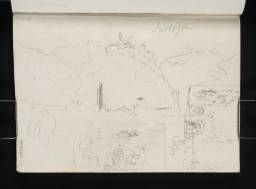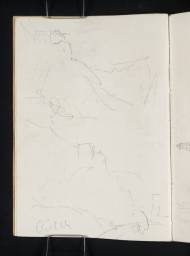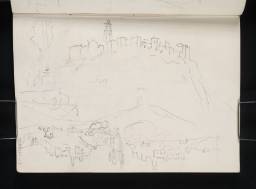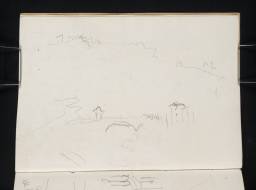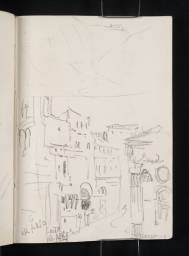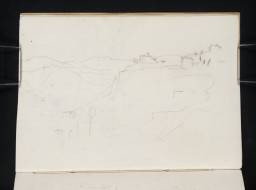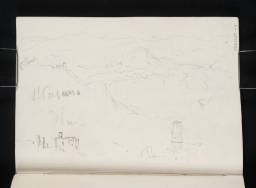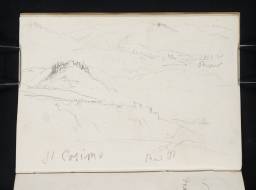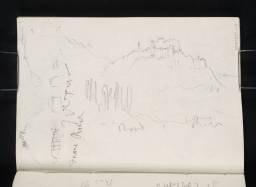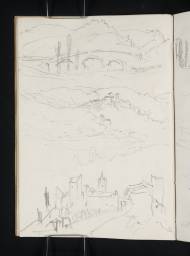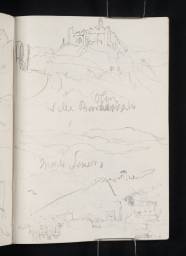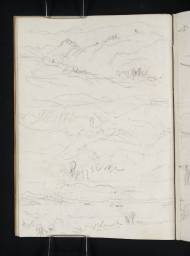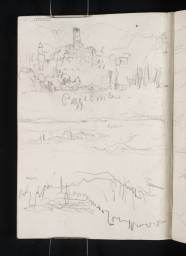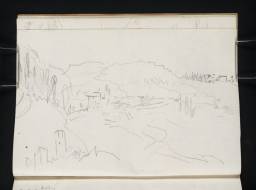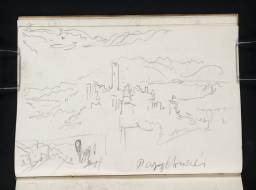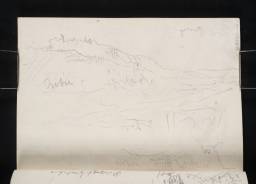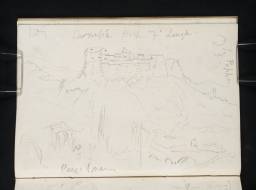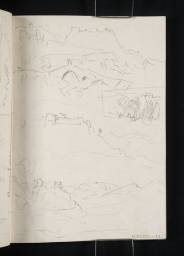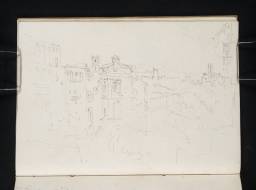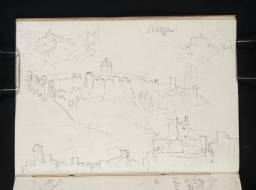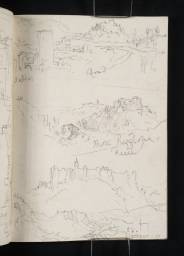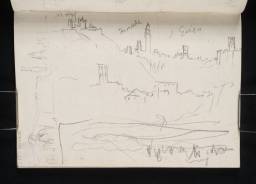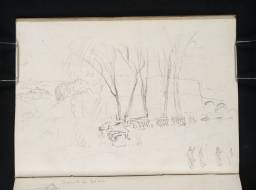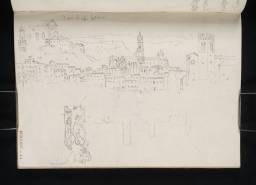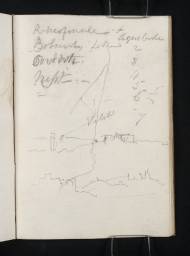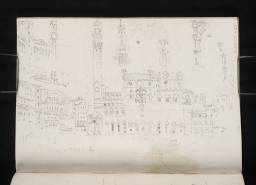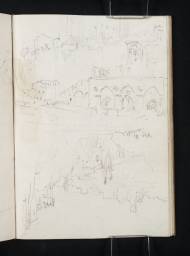Turner Bequest CCXXXIV 1–38a
Sketchbook rebound in modern brown card cover, replacing lost original mottled board cover with dark-green leather spine
38 leaves of white wove paper with modern free endpapers; approximate page size 148 x 104 mm
Inscribed in ink ‘CCXXXIV’ on front cover, top right
Inscribed in ink by Edward Croft-Murray inside front cover (see main catalogue entry)
38 leaves of white wove paper with modern free endpapers; approximate page size 148 x 104 mm
Inscribed in ink ‘CCXXXIV’ on front cover, top right
Inscribed in ink by Edward Croft-Murray inside front cover (see main catalogue entry)
Accepted by the nation as part of the Turner Bequest 1856
References
Turner used this sketchbook during his second major tour of France and Italy in 1828–9, as one of eight associated with this journey (see the overall tour Introduction). Chronologically, it is the fourth book in the sequence, and covers a relatively short leg of the artist’s outward journey to Rome. The title Florence to Orvieto was applied in Finberg’s 1909 Inventory of the Turner Bequest.1 However, Florence does not appear in this sketchbook, as it falls within the geographical remit of the previous Genoa and Florence sketchbook (Tate; Turner Bequest CCXXXIII), which is immediately followed by the present book.
In contrast with the predominantly coastal scenes of Liguria recorded in Genoa and Florence, the route embodied by Florence to Orvieto extends to around 115 miles of inland roads. Most of the locations depicted are in present-day Tuscany, especially the wider Siena region, which explains the profusion of rolling landscapes, hilltop villages and medieval fortifications. The final third of the sketchbook edges into the Viterbo province of Lazio and the Terni province of Umbria, concluding in Orvieto.
Continuing the trajectory of the Genoa and Florence sketchbook, the trail begins just south-west of Florence, near San Casciano in Val di Pesa. It then winds through Poggibonsi, Staggia Senese, Monteriggioni and Siena, where Turner produced several panoramas of the city’s skyline and major architectural landmarks. Continuing his journey south, he then passed Buonconvento, Torrenieri, San Quirico d’Orcia, Radicofani, Acquapendente, San Lorenzo Nuovo, Lake Bolsena, and finally Orvieto, which dominates the final section of the book. In the following Viterbo and Ronciglione sketchbook (Tate; Turner Bequest CCXXXVI), the route picks up again near Montefiascone, south-west of Orvieto.
On his first major tour of Italy in 1819–20, Turner travelled from Rome to Florence on the return leg of his journey via the Arezzo and Perugia road (see Nicola Moorby’s section in the present catalogue). For the present tour, undertaken a decade later, he charted an alternative route to Rome via Siena, an itinerary that gave him fresh encounters with unfamiliar towns and cities. For much of this journey, Turner’s route overlapped with the traditional Via Francigena, the ‘road originating in France’, a medieval pilgrimage route frequented by travellers from the north as they journeyed towards Rome.2 Beyond its religious association, the Via Francigena was also an established mercantile route, facilitating the transportation of wares including silk and spices from the East.3 Locations such as Acquapendente, Radicofani and Buonconvento were major stop-off points along this trail, and were therefore well equipped to provide travellers with respite. Occasionally, Turner’s sketches bear traces of these longstanding pilgrimage traditions: see, for example, the Medici hostelry and fountain in Radicofani, depicted on folio 24 verso (D21635).
Florence to Orvieto is characteristic of Turner’s sketching practices as a traveller; its pages are crammed with cursory studies and shaky inscriptions, swiftly executed from a moving carriage, often with the sketchbook oriented in different positions for maximum efficiency. Detailed architectural surveys – a more time-consuming undertaking – are comparatively rare, and reserved for the larger towns and cities where Turner presumably stayed for longer periods. For comprehensive listings of these major sites, see under folio 10 verso (D21607) for Siena, and folio 23 verso (D21633) for Radicofani.
Appearing on twenty pages of this sketchbook, Orvieto deserves particular mention as the most widely represented subject: see folios 30 recto–38 verso (D21646–D21663), and folios 2 verso and 5 recto (D21590, D21596). Turner made a special detour to see it, extending his itinerary and his journey time to Rome. Perched high on a volcanic rock, Orvieto’s picturesque topography evidently made a deep impression on him. Turner’s sketches range from swift topographical outlines of its rocky profile to detailed surveys of its churches, gateways and fortifications, and interior scenes within its cathedral. He later alluded to this comprehensive treatment of the subject in a letter to Sir Thomas Lawrence from Rome on 15 December 1828, declaring ‘Orvieto I have seen.’4 While Turner’s Orvieto sketches are a rich repository of detail in their own right, scholars including Cecilia Powell, Roland Courtot and Alberto Satolli have also discussed them in relation to the artist’s oil painting View of Orvieto, Painted in Rome (Tate N00511).5 This was one of many canvases he worked on in Rome over the winter of 1828–9, and which he also exhibited in the city: on this subject, see under folio 30 (D21646).
The geographical itinerary covered by the Florence to Orvieto sketchbook is broadly consistent, with only a few sketches falling outside the sequence. For example, a small number of views identified as Orvieto and Lake Bolsena appear nearer the beginning, rather than at the end. Finberg’s 1909 Inventory of the Bequest tended to assign generic titles to the works in this sketchbook, most of which have been updated in the present catalogue with more precise identifications. Finberg was somewhat over-eager in the number of hilltop towns he generically identified as Orvieto. Several studies have been reidentified or more accurately described here, and in this regard the present author is especially indebted to the scholarship of Powell and Courtot.6
The original length of the Florence to Orvieto sketchbook has prompted discussion among scholars, especially since the sketchbook was rebound in the 1930s. Finberg’s 1909 Inventory describes Florence to Orvieto as being ‘bound in mottled board, with dark green leather back’.7 However, subsequent damage to the sketchbook, possibly caused by the 1928 Tate Gallery flood, meant that a rebinding was deemed necessary, and the original binding was lost before or after this date. On inspecting the sketchbook’s composition in the 1930s, Edward Croft-Murray, Keeper of prints and drawings at the British Museum, wrote the following observation on the replacement covers: ‘I strongly suspect that this is a fragment of a much larger book, and that even in this there are several leaves missing which makes reconstruction impossible’. More recently, Cecilia Powell has also observed that a few of Turner’s sketches ‘may even have been lost or discarded, for Florence to Orvieto appears to be only a fragment from a once-thicker sketchbook’.8
The missing section, if indeed it existed at all, was presumably from the end of the sketchbook, given the relative coherence of the sequence up to this point. As Powell observed, the ‘lost pages’ of Florence to Orvieto may depict the hilltop village of Civita di Bagnoregio, south of Orvieto.9 These sketches, Powell added, were perhaps the basis of the 1828 oil painting Italian Landscape, probably Civita di Bagnoregio (Tate N05473).10 The loss of the original covers and the rebinding of the sketchbook make it more difficult to gauge its original length and composition.
For a map of the route, see ‘Full Via Francigena | From Lucca to Rome’, CaminoWays, accessed 24 June 2024, https://caminoways.com/via-francigena/via-francigena-from-lucca-to-rome ; on the historical background, see ‘History’, Vie Francigene, accessed 28 June 2024, https://www.viefrancigene.org/en/history/ .
Powell 1984 and 1987; Roland Courtot, ‘11. Vers Rome: de Florence à Orvieto (carnet CCXXXIV)’, Carnets de voyage de Turner, accessed 24 June 2024, https://carnetswt.hypotheses.org/2328 .
Technical notes
How to cite
Hannah Kaspar, ‘Florence to Orvieto Sketchbook 1828’, sketchbook, November 2024, in David Blayney Brown (ed.), J.M.W. Turner: Sketchbooks, Drawings and Watercolours, Tate Research Publication, February 2025, https://www

